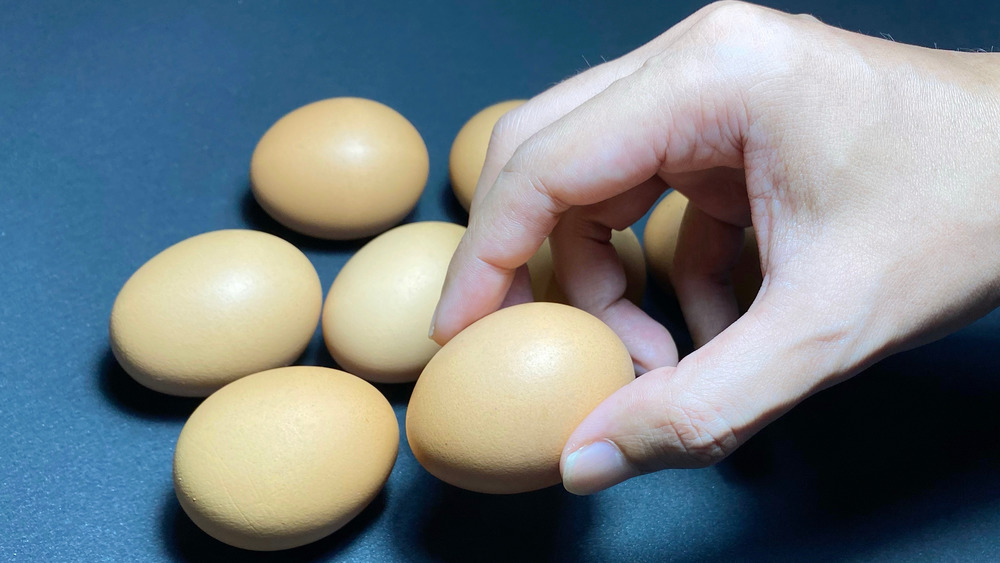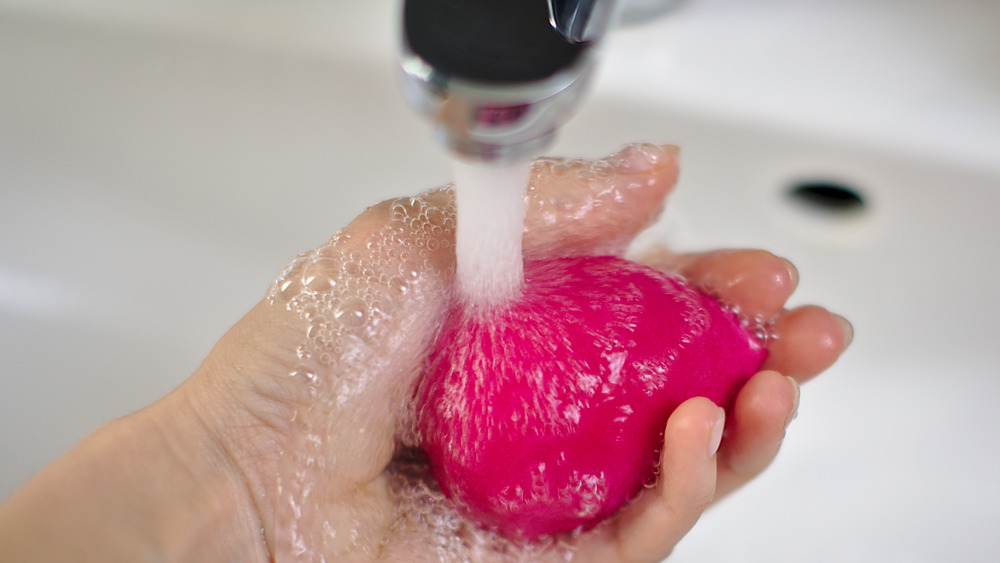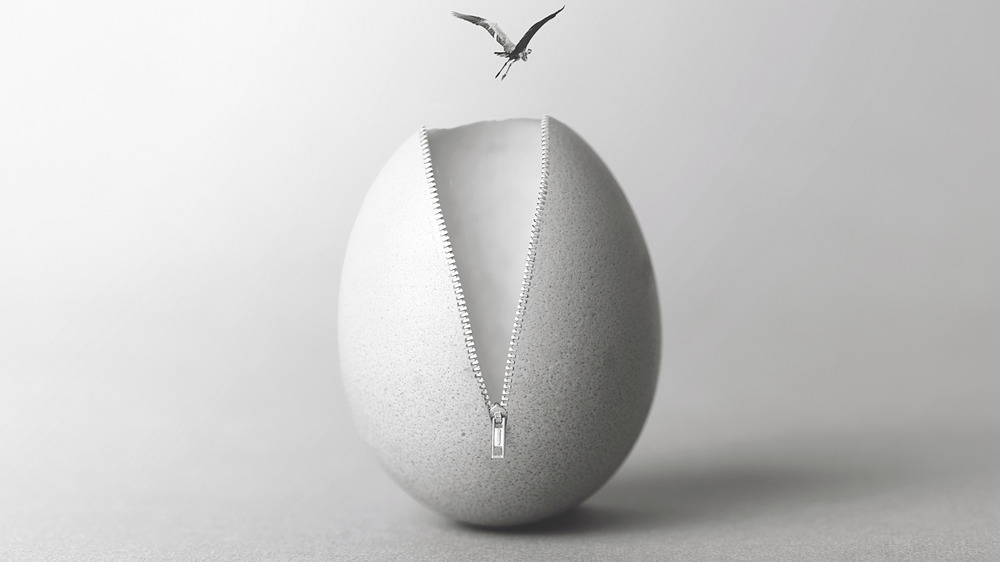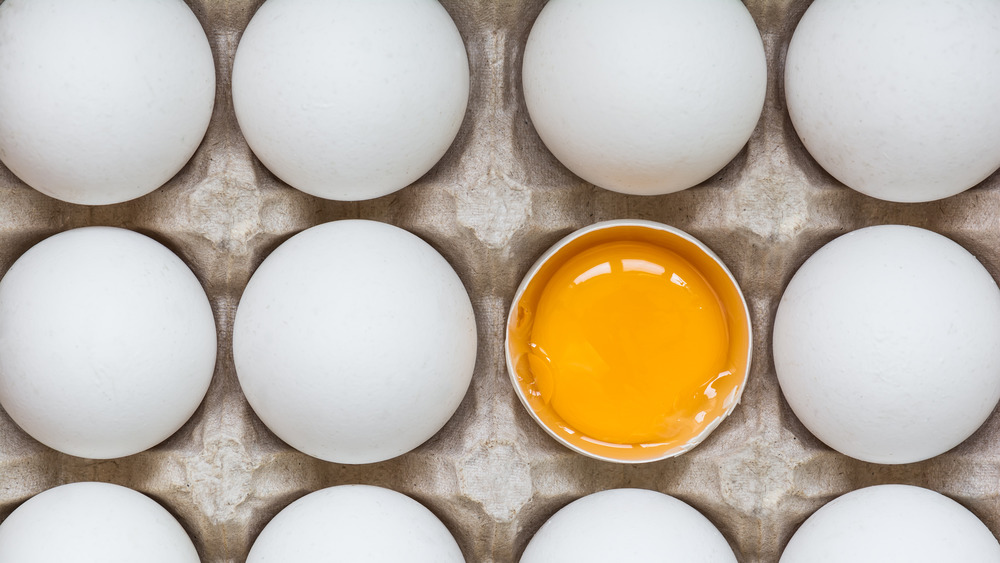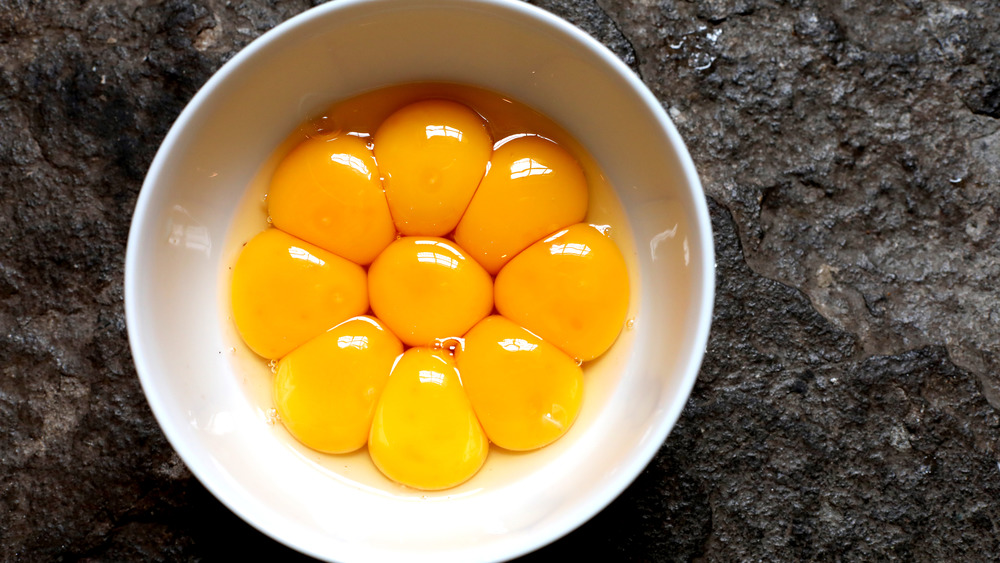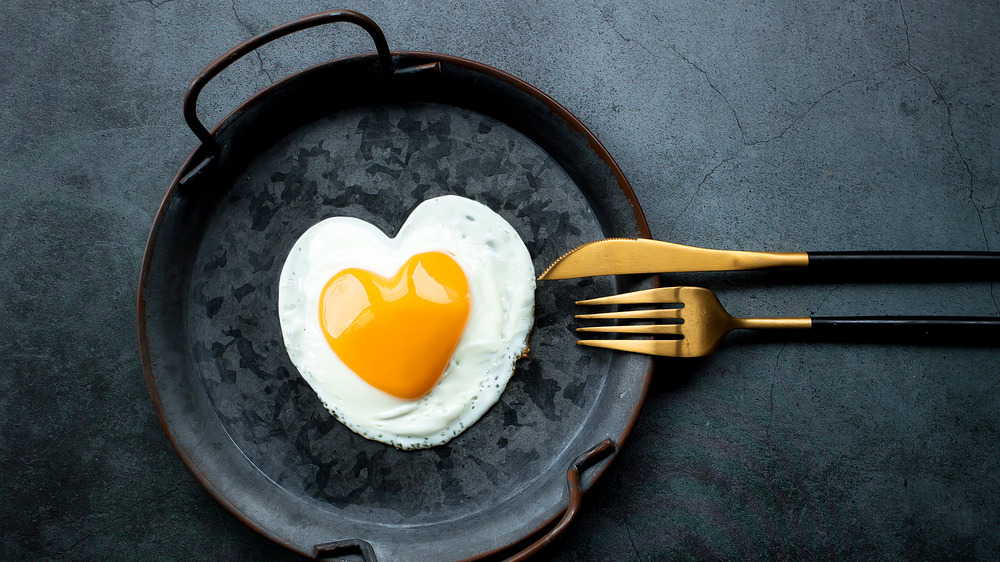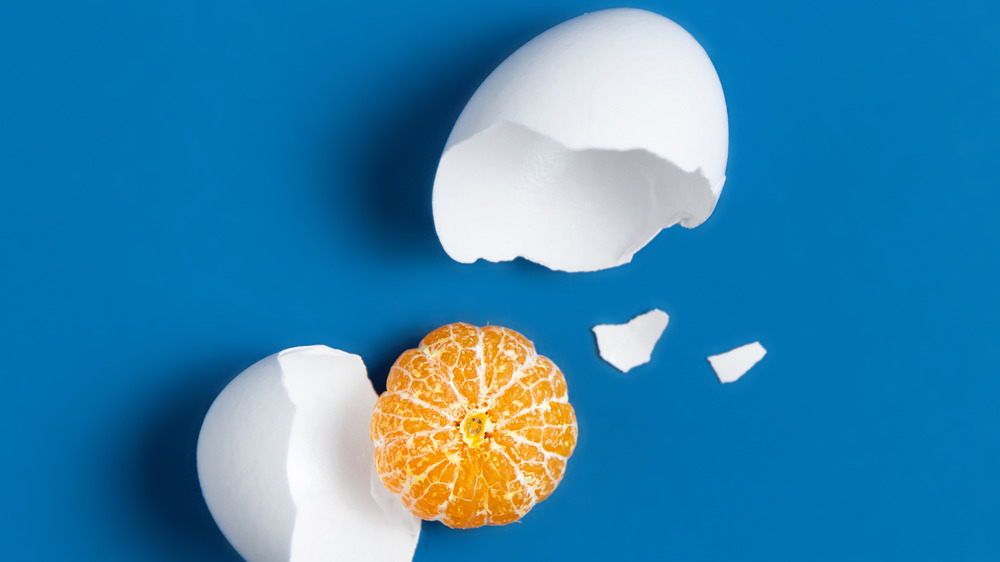Mistakes Everyone Makes When Cracking Eggs
It's no secret that eggs are not only delicious, but they're also quite possibly one of the world's most versatile foods. They're also affordable and easy to find at basically any grocery store or corner bodega. Eggs are perfect for eating on the go or for any meal of the day, whether you want your breakfast to kick the day off with protein and omegas, a fried egg sandwich for lunch or even poached eggs over quinoa or greens for dinner.
But as easy-to-find and versatile as eggs are, there's a lot of ways to mess them up! From cracking to separating, we may destroy that egg before we even get started — and that would be not only wasteful, but also sad. And of course, you don't want to have to throw your eggs out just because of a mess, or end up with shell in your food!
There's a lot of mistakes people make when cracking eggs, but the good news is, there's relatively easy ways to remedy or prevent those mistakes and to have a successful egg every time. According to the experts, the trick is practice, practice, practice, and a bit of technique doesn't hurt either. Here's some tips — from the pros themselves — to help you improve your egg cracking game (including how to do that one-handed trick from TV!).
Don't wash your eggs before cracking
Part of the reason it's not necessary to wash eggs is because they're already washed before you get them. In fact, the United States Department of Agriculture's federal regulations require egg producers to go through a process that involves washing their eggs and removing a protective coating that naturally occurs on them.
This process of washing eggs actually makes the egg more vulnerable to bacteria so after washing, an oily film is added to keep the egg safe and to avoid any bacteria getting inside. But the risk of washing the eggs once we buy them, according to this Reader's Digest, is that if the egg is porous, we may actually push that bacteria back inside, and no one wants that!
But there's another practical reason not to wash the egg before cracking: You may just break it
"Eggs are sorted and washed before being packaged and shipped to us for use. So, unless you are getting your eggs 'directly' from the chicken there is no need to rewash them," celebrity chef Jennifer Booker told Mashed. "Plus, you risk cracking them during your home washing process!"
Use the right surface to crack your eggs
Pretty much everyone knows that you need to crack an egg before preparing or enjoying them, but how to crack that egg is a whole other story. One thing you should know is that it comes down to finding the right surface — and one that won't cause a mess.
It's pretty impressive if you can manage to achieve a single firm tap resulting in an evenly cracked egg that splits open perfectly, before letting the yolk and the white smoothly slip out. And hopefully, you can do this while avoiding the shell shattering into a million pieces, getting bits of shell in the egg, breaking the yolk, or introducing any bacteria from the outside of the shell to the yolk or white — as might be the case for your average amateur chef. One pro-tip is to crack your egg on a flat surface — rather than the edge of a bowl — to prevent the egg shell from going inwards.
"I usually crack an egg by knocking two eggs together," Chef Andrew Forlines of CHEF AF LLC said to Mashed. Believe it or not, only one will crack at a time.
"I call this 'Warrior Eggs' and like to see how long of a winning streak an egg will go on," said Forlines, who says it's ok to use your finger to push out the last bit of egg white that sticks to the shell. But don't try to get fancy if you don't know what you are doing: "Unless you are in a hurry and will strain your eggs, don't crack them one handed. It's better to use two hands slowly and do it well," Forlines advised.
Don't push the crack inward to release your egg
You do have a better chance of not disturbing the contents of a fresh egg if you avoid cracking the shell inward. This is because eggs are delicate, according to Chef Jennifer Booker.
"Any pressure, like pushing the crack inward to release the egg into your bowl, will result in an exploding egg," Booker said to Mashed. The chef advises that once you crack the egg, you gently pull each end outward and empty your egg into your bowl.
One great method for doing this involves a knife: "For best results, you should hold the egg in the palm of your hand with the pointed end towards your fingertips," Scientist Sally Solomon said to The Telegraph. "You should then break it with a palette knife, striking it across the middle of the egg using the kind of wrist action used to cast a fly-fishing line."
Sounds rather intense, but it's surely worth a try!
Don't crack an egg directly into your cooking preparations
Another pro tip for cracking eggs is to not crack the egg into whatever you are cooking, but rather to crack it into a separate container. This is not only a good way to double check if the egg is spoiled, but there are other important reasons for the technique also.
"You never know when you're going to get a bad egg or a piece of shell with it, and it's a lot easier to fish out a shell fragment in a small bowl than in cake batter, for example," Executive Chef Phil Kastel of The Milky Way in Los Angeles told Mashed.
But there other reasons for this trick as well: Every now and then, the eggs we buy could have a spot of blood in the yolk, which is usually a result of vessels in a hen's ovaries. Regardless of the source, this is NOT an ingredient we want added to our recipe. "The easiest way to avoid these unpleasant surprises is to crack your eggs in separate bowl one at a time and discard any that don't make the cut," advised celebrity chef Jennifer Booker to Mashed.
How to do a one-handed crack like a professional chef
It seems that chefs on television love to show their expertise by casually cracking an egg with one hand while doing something else with the other, all without breaking a sweat. Could it really be that easy? Well, with practice and some technique – it can be!
"If you want a shell free cracked egg, there's one method that all of the pros use," New York City-based Egg Shop Kitchen Manager Davindra Sahadeo told Mashed.
According to Sahadeo, if you use one hand and give a quick tap on a flat surface, you will get an even crack with no shells every time. "Use your thumb to separate the egg shell where it is cracked and pour the goods right into a bowl or pan," advised Sahadeo.
But whatever your egg cracking maneuver, it's going to take some practice. "Practice, practice and then practice some more!" said celebrity chef Jennifer Booker to Mashed. Booker says that mastering one-handed egg cracking is really about finding a comfortable fit. "Try cracking the egg with one tap on the counter top and pulling opposite ends of the shell with your thumb and index/middle fingers-at the same time," the chef advised. And then, remember to keep practicing!
Don't break the yolk when you're trying to separate the egg
It's so annoying: You're attempting to separate your eggs, whether for an egg-white omelet or a beautiful souffle, and then the yolk breaks! Separating the eggs is a skill that some chefs take years to master, so it's understandable if it takes the rest of us a while to get the hang of. Here's a pro tip from celebrity chef Jennifer Booker: It's impossible to separate a broken yolk, so crack eggs individually in separate bowls to keep your whites clear as you go along.
"I have found the best way to keep your yolk whole when cracking an egg, is to open it facing up," Booker told Mashed. Once an egg cracked and facing upwards, gently pull each end of the shell apart, while making sure to keep the yolk in one half of the shell. "Using the other empty end of the shell to catch the yolk, gently pour it into the empty shell while allowing the egg whites to fall into your bowl," said Booker.
Another trick is to "gently bounce your hand up and down" while allowing the egg to hover above a mixing bowl to let the whites fall down, Nick Korbee of Egg Shop in New York City told Today. This may sound like a weird magic trick, but it's actually a gentle technique, according to Korbee, and it makes it easier to drop that yolk into a separate bowl if it starts to break apart in your hands (and before it gets mixed in with the egg whites!).
Don't let little sneaky bits of shell end up in your cracked egg
If cracking an egg without shell pieces landing in the bowl seems difficult, you should know it's even a struggle for professionals: "I thought I knew how to crack an egg but my very strict French chefs gleefully told me I was wrong" sommelier and Chef Laura Pauli of Cucina Testa Rossa in northern California, told Mashed.
Pauli says that to crack an egg you not to hit the side of the bowl, as "that forces small eggshell pieces into the egg." Instead, tap gently but firmly on a hard, flat surface on the widest part of the egg. "That usually — except when I'm demonstrating it live, of course — creates a clean crack all the way around the egg," Pauli added.
This is especially important if you need to separate your yolks and whites: "One drop of yolk in whites will hamper a good meringue and we can't have that!" Pauli advised.
If a couple of shell bits do drop in, here's a solution: "A clean index finger is the best tool to use when fishing them out," Celebrity Chef Jennifer Booker told Mashed.
Also, if you're cracking your eggs for a dish you're making later, shell bits will eventually settle to the bottom, and you can avoid them when pouring, or better yet — you can use shell to remove shell! "...A good trick is to use the shell to scoop them out — shell fragments tend to stick to other shell pieces like a magnet," Executive Chef Phil Kastel of The Milky Way in Los Angeles told Mashed.
Don't use an egg that is already cracked
It's all too common to open a container of eggs and see that one egg in the package you just brought home is already cracked. As tempting as it may be, our pros advise you never use an already-cracked egg.
"A crack indicates that air has gotten into the egg and that will cause spoilage," celebrity chef Jennifer Booker told Mashed. The best way to avoid cracked eggs is to check your carton of eggs while you're still in the market and to leave those cracked eggs behind, Booker advised.
While some experts do believe it's fine to use an egg after it's cracked open — if you use it quickly, or within two days – the problem seems to be in the difference between receiving a carton of eggs that has a cracked egg or if you accidentally crack it yourself once you own the egg. The difference is in the timing: If you see the egg cracked when you first open the package, you have no idea how or when it cracked. Chances are, that egg might have gone bad. Throw it out and don't take the risk! However, if you accidentally crack that egg while handling the carton — then it's likely fine. Just use the egg as soon as you can.
